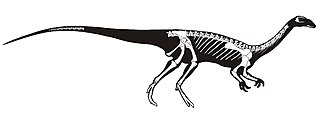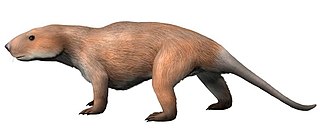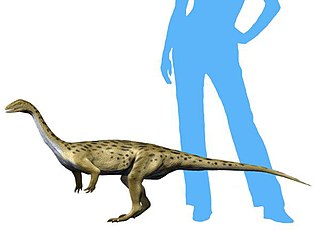
Eoraptor is a genus of small, lightly built, basal sauropodomorph dinosaur. One of the earliest-known dinosaurs and one of the earliest members of the sauropod family, it lived approximately 231 to 228 million years ago, during the Late Triassic in Western Gondwana, in the region that is now northwestern Argentina. The type and only species, Eoraptor lunensis, was first described in 1993, and is known from an almost complete and well-preserved skeleton and several fragmentary ones. Eoraptor had multiple tooth shapes, which suggests that it was omnivorous. Eoraptor was 1.5 feet tall and 3 feet long.

Sauropodomorpha is an extinct clade of long-necked, herbivorous, saurischian dinosaurs that includes the sauropods and their ancestral relatives. Sauropods generally grew to very large sizes, had long necks and tails, were quadrupedal, and became the largest animals to ever walk the Earth. The prosauropods, which preceded the sauropods, were smaller and were often able to walk on two legs. The sauropodomorphs were the dominant terrestrial herbivores throughout much of the Mesozoic Era, from their origins in the Late Triassic until their decline and extinction at the end of the Cretaceous.

Staurikosaurus is a genus of herrerasaurid dinosaur from the Late Triassic of Brazil, found in the Santa Maria Formation.

Saturnalia is an extinct genus of basal sauropodomorph dinosaur known from the Late Triassic Santa Maria Formation of Rio Grande do Sul, southern Brazil. It is one of the earliest known dinosaurs.

Herrerasauridae is a family of carnivorous dinosaurs, possibly basal to either theropods or even all of saurischians, or even their own branching from Dracohors, separate from Dinosauria altogether. They are among the oldest known dinosaurs, first appearing in the fossil record around 233.23 million years ago, before becoming extinct by the end of the Carnian stage. Herrerasaurids were relatively small-sized dinosaurs, normally no more than 4 metres (13 ft) long, although the holotype specimen of "Frenguellisaurus ischigualastensis" is thought to have reached around 6 meters long. The best known representatives of this group are from South America, where they were first discovered in the 1930s in relation to Staurikosaurus and 1960s in relation to Herrerasaurus. A nearly complete skeleton of Herrerasaurus ischigualastensis was discovered in the Ischigualasto Formation in San Juan, Argentina, in 1988. Less complete possible herrerasaurids have been found in North America and Africa, and they may have inhabited other continents as well.

Herrerasaurus is likely a genus of saurischian dinosaur from the Late Triassic period. This genus was one of the earliest dinosaurs from the fossil record. Its name means "Herrera's lizard", after the rancher who discovered the first specimen in 1958 in South America. All known fossils of this carnivore have been discovered in the Ischigualasto Formation of Carnian age in northwestern Argentina. The type species, Herrerasaurus ischigualastensis, was described by Osvaldo Reig in 1963 and is the only species assigned to the genus. Ischisaurus and Frenguellisaurus are synonyms.

Guaibasaurus is an extinct genus of basal saurischian dinosaur known from the Late Triassic Caturrita Formation of Rio Grande do Sul, southern Brazil. Most analyses recover it as a sauropodomorph, although there are some suggestions that it was a theropod instead. In 2016 Gregory S. Paul estimated it at 2 meters and 10 kg, whereas in 2020 Molina-Pérez and Larramendi listed it at 3 meters and 35 kg.

Guaibasauridae is a family of basal sauropodomorph dinosaurs, known from fossil remains of late Triassic period formations in Brazil and Argentina.

The Santa Maria Formation is a sedimentary rock formation found in Rio Grande do Sul, Brazil. It is primarily Carnian in age, and is notable for its fossils of cynodonts, "rauisuchian" pseudosuchians, and early dinosaurs and other dinosauromorphs, including the herrerasaurid Staurikosaurus, the basal sauropodomorphs Buriolestes and Saturnalia, and the lagerpetid Ixalerpeton. The formation is named after the city of Santa Maria in the central region of Rio Grande do Sul, where outcrops were first studied.

The Caturrita Formation is a rock formation found in Rio Grande do Sul, Brazil. Its sediments were deposited in the Paraná Basin. The formation is from the Upper Triassic and forms part of the Santa Maria Supersequence in the upper section of the Rosário do Sul Group.

Jachaleria was a dicynodont herbivore that lived from the Ladinian to Norian stages of the Middle to Late Triassic, from approximately 240 to 220 million years ago. Jachaleria was one of the last representatives of the dicynodonts, occurring in Argentina and Brazil. It lacked teeth, much like Stahleckeria, but was closer in size to Dinodontosaurus.

Riograndia is an extinct genus of prozostrodontian cynodonts from the Late Triassic of Brazil. The type and only species is Riograndia guaibensis, named after the State of Rio Grande do Sul and Guaíba Basin, where it was discovered. Remains have been found in the Caturrita Formation of the geopark of Paleorrota. It was a small non-mammalian cynodont, with several advanced features also present in mammals. Several specimens of Riograndia guaibensis have been found in the towns of Candelária and Faxinal do Soturno in the Caturrita Formation. The genus defines the Riograndia Assemblage Zone.

Saturnaliidae is a family of basal sauropodomorph dinosaurs found in Brazil, Argentina and possibly Zimbabwe. It is not to be confused with Saturnalidae, a family of radiolarian protists.
Teyumbaita is an extinct genus of hyperodapedontine rhynchosaur from the Upper Triassic of southern Brazil. Its fossils were recovered from the early Norian-age Caturrita Formation, one of several fossiliferous formations exposed at Paleorrota Geopark in the state of Rio Grande do Sul. Teyumbaita is likely the youngest valid genus of rhynchosaur, as other members of the group likely died out before the start of the Norian.
Pampadromaeus is an extinct genus of basal sauropodomorph dinosaurs known from the Late Triassic (Carnian) Santa Maria Formation of the Paraná Basin in Rio Grande do Sul, southern Brazil.

Buriolestes is a genus of early sauropodomorph dinosaurs from the Late Triassic Santa Maria Formation of the Paraná Basin in southern Brazil. It contains a single species, B. schultzi, named in 2016. The type specimen was found alongside a specimen of the lagerpetid dinosauromorph Ixalerpeton.

Unaysauridae is a clade of basal sauropodomorphs from the Late Triassic of India and Brazil.

Macrocollum is a genus of unaysaurid sauropodomorph dinosaur that lived during the Late Triassic period in what is now Brazil. It is one of the oldest dinosaurs known.

Nhandumirim is a genus of basal sauropodomorph dinosaur from the Carnian age of Late Triassic Brazil. It is currently considered a saturnaliid sauropodomorph. The type and only species, Nhandumirim waldsangae, is known from a single immature specimen including vertebrae, a chevron, pelvic material, and a hindlimb found in the Santa Maria Formation in Rio Grande do Sul.

The Candelária Formation, in other literature also referred to as Candelária Sequence, is a sedimentary formation of the Santa Maria Group in the Paraná Basin in Rio Grande do Sul, southeastern Brazil. The formation dates to the Carnian of the Late Triassic, locally referred to as Tuvalian, from 231.4 to approximately 222 Ma.






























